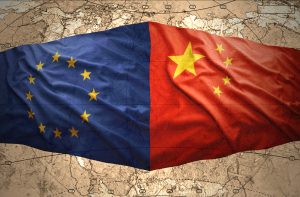Last October saw the launch of a European Union probe designed to determine whether Chinese-made electric vehicles (EVs) benefitted unfairly from state subsidies. Many saw this as the culmination of European Commission efforts under President Ursula von der Leyen to pursue EU autonomy in green technologies vis-à-vis China.
However, with barely two months left until the European elections, the Commission has launched a new foreign subsidies probe into Chinese-made wind turbines. European Commission Executive Vice President Margrethe Vestager announced that the probe, similarly targeting subsidies from the Chinese government, will be aimed at five windmill parks located in Spain, France, Greece, Romania, and Bulgaria.
In her speech, Vestager framed this action within a broader context, quoting from the film “Oppenheimer”: “This is not a new weapon, it is a new world.” She emphasized three key points: platform regulation, the role of AI, and economic security. In addition to the probe, which falls under the latter point, Vestager stressed the importance of aligning development with regulatory efforts and innovation, stating that “laws exist to mitigate the risks, and open up markets that have been closed down.” She opened the door to further regulatory protectionism in key sectors beyond the two probes announced in the last six months.
These initiatives demonstrate the Commission’s utilization of its new powers under its Foreign Subsidies Regulation, aimed at addressing market distortions caused by subsidies from foreign governments and ensuring that EU companies are competing on a level playing field. The announcement came just days after the Commission opened a separate subsidies probe into Chinese companies bidding for a solar farm contract in Romania. In her speech, Vestager pointed out that less than 3 percent of solar panels installed in Europe are produced domestically, underscoring the need to prevent a similar scenario in electric vehicles, wind energy, and essential chip manufacturing.
EU turbine producers were already concerned regarding third-country challenges in the sector. Although the European market is still largely dominated by domestic players such as Vestas, Enercon, Nordex, and Siemens Gamesa, overcapacity in the Chinese market has led to more exports abroad. While European producers still occupy top spots in terms of global turbine provision, the Chinese firm Goldwind is quickly encroaching on EU dominance over the sector. In 2022, China was the largest global wind market, contributing 54 percent of the year’s new wind capacity, and Goldwind took over the top global market share position, previously occupied by Vestas.
Earlier this year, the CEO of Siemens Energy – the parent company of Siemens Gamesa, one of the world’s top producers of wind turbines – lamented the influx of “cheap Chinese wind power equipment” into the single market. This statement came after Siemens Gamesa had incurred significant losses in 2023. Rising raw material costs have further strained European producers, making their products more expensive and leading EU companies to revert to buying Chinese goods, which are cheaper and often come with attractive deferred payment deals.
In addition, the timing of the announcement may have not been optimal. Chinese Commerce Minister Wang Wentao was in Paris to advocate for Chinese EVs in light of the October 2023 probe when the turbine probe was announced. Furthermore, the EU had just sent climate envoys to Beijing earlier the same week to hold climate talks, seeking transparency and greater contributions to funding poorer countries fighting climate change.
Additionally, U.S. presidential elections are looming, and the possibility of Donald Trump entering the Oval Office for a second time might shatter EU dreams of a shared consensus among G-7 members. Part of the EU strategy, as announced in Vestager’s speech, would be to rely on like-minded partners to create shared “trustworthiness criteria for critical clean technologies.” These criteria would then be applied globally and to all like-minded partners. Yet, without global cooperation, these criteria might as well burden the EU, especially if the United States were to continue pushing its domestic market as they did with the Inflation Reduction Act. All of this would be exacerbated by an uncooperative Trump presidency.
Chinese authorities have responded to the announcement of the second probe in a similar vein as they did when the investigation into Chinese-made EVs was launched back in October. A statement released by the Chinese Ministry of Commerce the day after Vestager’s announcement said that “China believes that the Foreign Subsidies Regulation investigations initiated by the EU … have not only severely damaged the confidence of Chinese enterprises in investing and trading in Europe, but also interfered with mutually beneficial industrial cooperation between China and Europe.” The statement further accuses the EU of “distorting China’s policies, market environment and economic system, creating excuses for subsequent discriminatory anti-dumping practices.”
A day later, ministry spokesman He Yadong declared that the probe into wind turbines “is typical protectionism, which will deal a heavy blow to the global response to climate change and the green transition.”
As the von der Leyen presidency concludes, the responsibility for addressing the outcomes of these probes falls to the next Commission. Recent events suggest that the future of China-EU relations will likely remain turbulent, probably regardless of the outcome of the U.S. elections. Through regulatory efforts, the EU is seeking to consolidate its cleantech market, and this comes with very high barriers to Chinese goods. Especially in a moment of tepid Chinese economic development, it is expected that Beijing will try to seek further cooperation with the EU, while holding long-standing partners, such as Russia, closer.
Finally, while not decisive, the EU will need to see who will be in the White House in January 2025 to determine whether a widespread consensus is in the books. If not, the EU’s ability to achieve its environmental goals without sacrificing its internal market or competitiveness will hinge on navigating these complex dynamics and forging new partnerships that align with its regulatory objectives.
The EU’s probe into Chinese subsidies represents not a new development, but rather a continuation of the tensions already in the air.

































